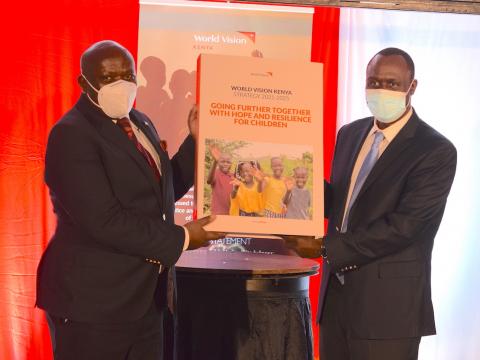World Vision Kenya Launches New Strategy

By Sarah Ooko, World Vision Senior Communications & Media Officer, Kenya
World Vision Kenya has launched its five-year strategy (2021-2025), which seeks to improve the well-being of children, families and communities in Kenya.
The strategy, titled Going Further With Hope and Resilience for Children,, seeks to contribute to improved and sustained well-being of over eight million vulnerable children in Kenya. This will be achieved through fundraising and investing over 30 Billion Kenya Shillings (USD 300 Million) over the five-year period. The finances will be raised through enhanced resource acquisition both locally and internationally.
With the new road map, the organisation is deliberately seeking to increase its presence in fragile contexts, which include conflict prone areas and informal urban settlements in Kenya's towns and cities.

"We commit to go to the hardest-to-reach places so as to ensure that no vulnerable child is left behind," noted Lilian Dodzo, the National Director for World Vision Kenya.
The targeted children and priority areas for the strategy were carefully identified and chosen through a national level vulnerability census mapping.
It disaggregated the different types of vulnerabilities affecting children in Kenya such as abusive or exploitative relationships, extreme deprivation, serious discrimination, disability and catastrophic disasters.
The new strategy is a product of collaborative efforts between the organisation and key stakeholders including children, community members, government bodies, faith leaders, civil society organisations and private sector players.
They all provided great insights into challenges affecting children as well as ways in which those problems could be solved through effective development strategies and partnerships.

“Thank you for allowing us to participate in the development of the new strategy. I am happy to see that our views, as children, were captured and that the strategy will help protect us from violence and exploitation,” said 14-year-old Yvonne.
Paul Lilian, the Chair of the World Vision Kenya Board, called for increased advocacy to facilitate the enactment of policies that will help safeguard the rights of children in the country.
"Based on my review of the strategy, I am glad that World Vision Kenya has not abandoned its commitment to vulnerable children and families. Thank you for supporting the government to improve the well-being of children in Kenya,” noted Eric Wafukho, the Chief Administrative Secretary, National Treasury & Planning, for the government of Kenya. He was the Chief Guest of the launch ceremony.
James Ang’awa, the Programme Effectiveness and Impact Director for World Vision Kenya noted, “Through this strategy, we want to focus on evidence-based results, as we improve the well-being of vulnerable children, families and communities in Kenya.”
He noted that the organisation is therefore taking a bold step to invest in research, innovation and Information, Communication and Technology (ICT) through partnerships with research and academic institutions.